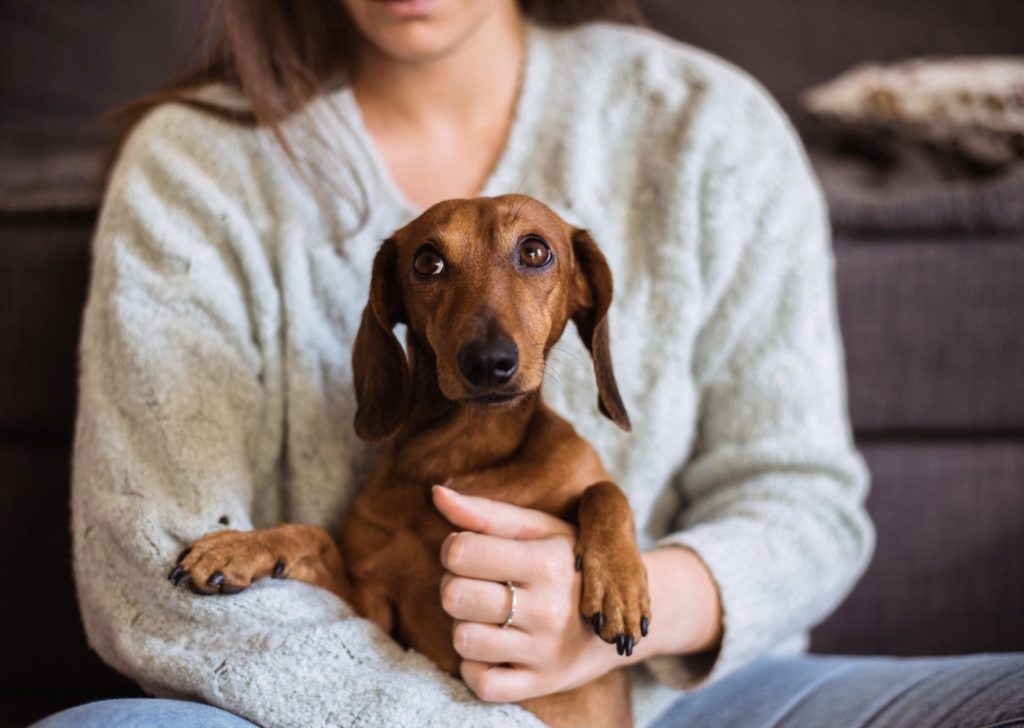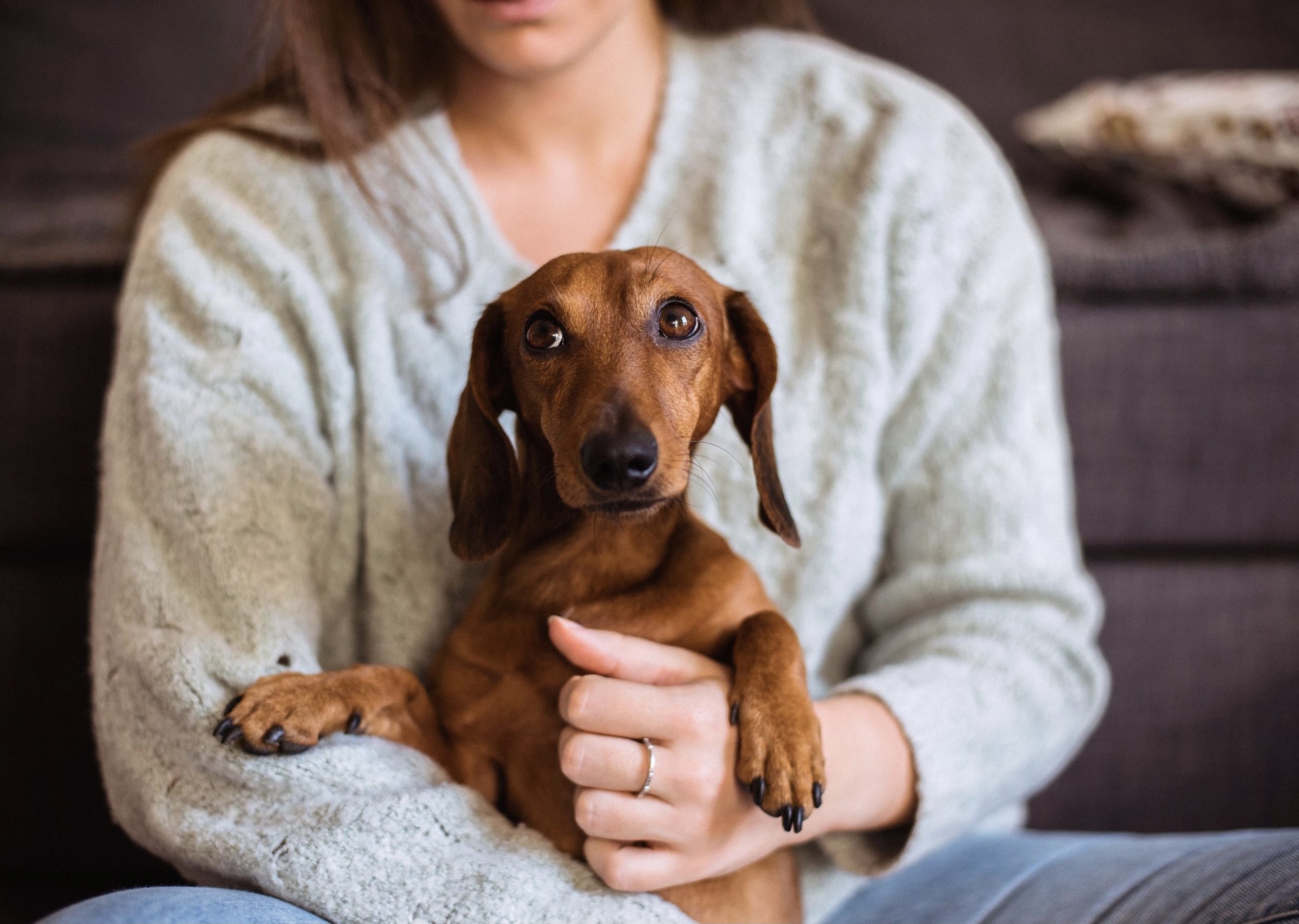
If We Are Anxious, Can Our Dogs Become Anxious Too?
Anxiety disorders are not contagious in the literal term but there is a correlation between atypical anxious behaviours in dogs and anxiety in their caregivers.
As a specialist in canine anxiety, part of my evaluation and diagnosis consists in observing the interaction between a dog and their owner. If you have felt that your dog knows when you are upset, sad or angry it is because they do know. They are extremely good at picking up on their owners emotions.
Dogs always seem to understand when we need a cuddle to cheer us up or when we need a friend to act silly or to stay away from you when you relieve stress or anger.

How Do Dogs ‘Smell’ Anxiety?
Dogs have many ways of detecting human feelings including observing our body language, facial expressions, the tones of our voice and more subtle changes in the smell of our sweat, tears or pheromones.
Dogs learn to associate the sounds that you are making with the behaviours you do. They can also predict when you are going to react with anger, when you are going to reward them because you are pleased, or when you are going to act unusually based on your anxiety.
Ever heard anyone say their dog ‘looked’ guilty when they came home to find they had been in the kitchen bin? Dogs do not feel guilty in the sense that we do. What is far more likely is that the dog has learned to predict your angry behaviour from previous times. They can see the changes in your body language, voice and facial expression.
Dogs detect subtle chemical changes in our bodies with their sense of smell. They have what is called the vomeronasal organ (VNO) located just above the roof of their mouth. The vomeronasal chemosensory system detects pheromones and other chemicals in both the oral and nasal cavity.
The sensory receptors in the VNO detects specific non-volatile organic compounds which are conveyed through the environment. These include hormonal changes, compounds in sweat and tears which triggers appropriate behavioural responses. Many species such as snakes, lemurs, elephants, cats, horses, cattle and pigs all use their vomeronasal organ to discriminate between different substances.
When we are anxious, we sweat which is why you may have heard the phrase dogs can “smell fear.” Their ability to detect tiny chemical changes is why we can train medical detection dogs or assistance dogs to detect diseases such as cancer, Covid-19 or warn when someone will have a seizure.
Do Humans Have a Vomeronasal Organ?
Yes! It is present in humans and has been retained during the process of evolution but is non-functional.
Why Do Dogs Feel Anxious When You Do?
Dogs often learn to look to their owners for cues on how to deal with and react to the world around them. This is particularly evident in young and anxious dogs who lack confidence. When owners project feelings of calmness and confidence, dogs tend to see their immediate surroundings as safe.

When humans are anxious, dogs tend to look to their environment for signs of threats, they feel less safe and thus more anxious. After all, there must be some reason that their protector is feeling anxious.
What Happens When Dogs Feel Anxious?
There are several symptoms of anxiety in dogs that you should look out for, especially if you feel anxious near your dog. There is a big difference between a canine anxious disorder and misbehaviour. Although I will list below some common signs of anxiety in dogs, many of these occur also during normal development so it is best not to ‘self-diagnose’ your dog and get a professional such as myself at The Confident K9 to do a more formal assessment, diagnosis and treatment plan.
Signs of Anxiety in Dogs:
- Destructive behaviours, such as chewing pillows or furniture, relentless scratching at doors and windows
- Constant barking, whining or howling
- Urinating or defecating indoors
- Intense, persistent pacing
- Attempting to “escape” a room or crate to the point of self-injury
- Physiological responses, such as dilated pupils or excessive panting
- Self-mutilation
- Being withdrawn or ‘shutdown’
- Shaking and tremors
If these signs are visible on a regular basis, it may mean your dog has an anxiety disorder instead of just a general feeling of anxiety so contact a professional like me at The Confident K9 as soon as possible. We can also help with separation anxiety and separation-related issues.
If you regularly feel anxious, you might in some cases even be the perfect candidate for a dog bite.
Dogs can quite often react to anxious humans and become anxious themselves. For example, a person who is anxious or fearful might tense up and stare. Dogs can take this as a challenging posture and become anxious and defensive.
A study published in the Journal of Epidemiology and Community Health suggests that less emotionally stable people are more likely to be bitten by dogs. This is a correlation, not a causation, but it’s possible that anxious behaviours lead to dogs feeling more anxious and responding with fear and/or aggression.
Like Dog, Like Owner: What Breeds Say About Personality
Check out an article by Live Science here on what your dog’s breed says about you.
Are My Mental-Health Issues Having a Negative Effect On My Dog’s Behaviour?
There is no clear-cut answer to this because it really depends on the relationship between the individual dog and owner. Depression and anxiety are not contagious diseases and you can’t ‘give’ your dog anxiety or depression.
There are rare occasions where dogs are born with a predisposition to be anxious, however, most of the time anxiety in dogs is something that is exacerbated by nurture not nature.
What Can You Do To Help Your Dog Feel Less Anxious?
If you suffer from anxiety, you must prioritise your own mental health. Not only for your wellbeing but for your dog’s wellbeing too.
Your dog will benefit from you being less anxious. If you feel that you are anxious, there are many ways that you can make sure your dog is the least affected by your anxiety.
1. Try to maintain the same routine every day. If you maintain similar order in your day-to-day activities this gives your dog an element of predictability and therefore predictive expectations. Although you do not have to time things by the minute, it helps your dog to know what is happening next in their day when you stick to a routine.
2. Take your dog on walks daily. Getting out of the house is good for both you and your dog. You can either go alone or with a member of your support network. Physical exercise every day can reduce your risk of many health issues such as heart disease, lower anxiety and relieve stress. Practising mindfulness techniques can also be extremely helpful.
Being outside and sniffing all the scents left by the other people, pets and wildlife in the neighbourhood will provide a lot of mental stimulation for your dog. The length of your walk should always be appropriate for the size, age and ability of your dog. Remember, regular walks are better for your dog’s physiology and conformation rather than what I call ‘weekend warriors’ who don’t walk much in the week and take their dogs on huge hikes at the weekend.
3. Introduce some food puzzle toys as a fun activity and allow your dog to work for some of his food. Puzzle toys provide mental stimulation for your dog and hopefully will spend less time engaging in inappropriate activities. Simple scattering games or hiding treats in rolled-up towels or cardboard boxes can also be quick and easy.
4. Work on brief training exercises using positive reinforcement training. Teaching your dog new tricks is not only enjoyable for both you and your dog, it builds your healthy bond and can help take your mind off your worries and anxieties. These sorts of activities can help improve the mental attitude of both dog and owner.
5. Cuddles and occasional duvet days! A number of studies have shown that petting a dog can help lower blood pressure and increase the release of serotonin and endorphins for both dog and owner.
Give Your Dog Plenty Of Love And Attention.
It can be easy to get stuck in your own anxiety and forget about your dog’s needs. Studies show that interacting with your dog can reduce stress and anxiety, which will benefit both of you.

What can you do if you would like help with your mental health?
First and foremost, look at your immediate social support network. This can be friends, family, neighbours, colleagues or other professionals. Keep regular contact with members of your social support network and make sure they know how you feel. Don’t be afraid or embarrassed to reach out and let them know. After all, if someone reached out to you for support, you would be the first to want to help.
“Anything is possible if you have the right people there to support you.”
Here are some useful organizations to contact for help about mental health:
NHS – Urgent Help Herefordshire and Worcestershire
Healthy Minds Herefordshire and Worcestershire
At The Confident K9 we are specialists in canine behaviour.
To find out more about how you can help your dog, please contact ushere.
Adelaide Stewart-Jones BSc (Hons) IMDT
Dog Behaviourist and Accredited Trainer








Comments are closed